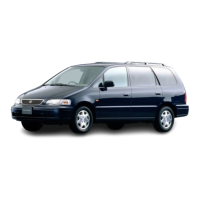
Do you have a question about the Honda Odyssey 1995 and is the answer not in the manual?
| Brand | Honda |
|---|---|
| Model | Odyssey 1995 |
| Category | Automobile |
| Language | English |
Explains the meaning of safety alert words: DANGER, WARNING, and CAUTION.
Explains the purpose of the NOTICE symbol for property damage warnings.
Details the vehicle's occupant protection system including seat belts and airbags.
Explains the fundamental importance of wearing seat belts for safety.
Provides critical reminders for safe passenger restraint and seating.
Lists the components of the Supplemental Restraint System (SRS).
Explains how the SRS and airbags function during a severe frontal collision.
Provides key information about airbag operation, limitations, and potential risks.
Explains the importance of seat-back position for seat belt effectiveness.
Details proper adjustment of head restraints to prevent neck injuries.
Provides guidance on securely storing cargo to prevent injury or operational interference.
Recommends rear seat placement for children and discusses airbag hazards.
Offers guidelines for properly restraining children under 18 kg in child seats.
Guides on restraining children over 18 kg using seat belts or booster seats.
Emphasizes the importance of not drinking and driving.
Warns against enclosed areas and activities that expose one to carbon monoxide.
Explains NHTSA's process for investigating safety defects based on complaints.
Refers to safety labels related to the vehicle's battery, warning of hazards.
Lists and describes the various indicator lights on the instrument panel.
Explains the function and display of the vehicle's gauges.
Details the controls located on or near the steering wheel for driver convenience.
Explains how to operate headlights, including changing between low and high beams.
Details how to use the turn signal lever for turns and lane changes.
Explains the operation of the windshield wipers and washers.
Details how to operate the windshield washers.
Introduces cruise control and its limitations for use.
Explains the positions of the ignition switch and anti-theft lock.
Details how to operate the power door locks using the master switch and lock tabs.
Describes the seating configurations for six and seven-passenger models.
Provides instructions for adjusting the driver's seat forward and backward.
Describes third seat access for the six-passenger model.
Describes the AUTO function for the driver's window.
Explains how to operate the sunroof on applicable models.
Details how to adjust power outside mirrors using selector and adjustment switches.
Explains how to apply and release the parking brake and its effect on ABS.
Introduces the heating and air conditioning system for climate control.
Introduces the audio system, its ease of use, and reception capabilities.
Explains the function of fan control, temperature control, mode buttons, and A/C switch.
Provides guidance on using the system for ventilation, cooling, and heating.
Guides on operating the radio, adjusting volume, and selecting bands.
Explains methods to find radio stations using TUNE, SEEK, or Preset buttons.
Explains how the audio system disables itself when power is lost and requires a code.
Provides recommendations for breaking in a new car to ensure reliability.
Advises on the type of gasoline to use and potential issues with low octane or leaded fuel.
Provides step-by-step instructions for safely filling the fuel tank.
Details the procedure for safely opening the vehicle's hood.
Provides tips on driving habits to improve fuel economy.
Discusses Genuine Honda Accessories and aftermarket options.
Provides a method to calculate the maximum cargo weight allowed.
Outlines daily checks and adjustments before driving the car.
Provides tips on starting the engine under various conditions.
Explains the different shift lever positions and their functions.
Describes audible brake wear indicators and when to replace brake pads.
Explains how ABS works, its benefits, and the ABS indicator light.
Explains the importance of tire condition and pressure for traction.
Advises on respecting trailer weight limits based on vehicle capacity.
Provides advice on selecting and installing proper trailer hitches.
Explains how towing affects vehicle handling due to crosswinds and buffeting.
Lists crucial safety precautions to follow before performing any maintenance.
Guides the user on selecting between Normal and Severe Conditions maintenance schedules.
Outlines tire checks for pressure, wear, and objects.
Provides step-by-step instructions for checking engine oil level.
Advises on selecting the correct API service grade and viscosity for engine oil.
Provides steps for adding engine coolant to the radiator and reserve tank.
Explains how to check automatic transmission fluid level and the correct fluid to use.
Guides on checking brake fluid level and replacement intervals.
Explains how to check power steering fluid level and the correct fluid to use.
Specifies replacement intervals for the air cleaner element.
Provides step-by-step instructions for replacing spark plugs.
Advises on monthly checks for battery condition and terminals.
Warns that charging the battery with cables connected can damage electronic controls.
Advises on checking wiper blade condition and replacing them when worn.
Explains how to check drive belts for wear and tension.
Emphasizes the importance of proper tire type, size, tread, and inflation for safety.
Explains the importance of proper tire inflation for handling, tread life, and safety.
Emphasizes monthly checks of exterior lights for safety and visibility.
Provides step-by-step instructions for replacing a halogen headlight bulb.
Provides a comprehensive guide on preparing a car for extended storage.
Offers guidance on washing the car to preserve its finish and prevent damage.
Explains how to clean seat belts and the importance of proper retraction.
Highlights built-in corrosion protection and simple maintenance actions.
Explains how body repairs can impact corrosion resistance and the importance of genuine parts.
Explains the use and precautions for the compact spare tire.
Emphasizes stopping in a safe location to change a flat tire.
Guides on diagnosing issues when the engine won't start or cranks slowly.
Provides instructions and precautions for jump starting a car with a booster battery.
Explains how to read the temperature gauge and the dangers of overheating.
Explains the function of the low oil pressure indicator and immediate actions required if it illuminates.
Explains the meaning of the check engine light and necessary actions if it illuminates.
Guides on troubleshooting and manually closing the sunroof if the motor fails.
Explains the purpose and location of fuse boxes in the vehicle.
Provides instructions for checking and replacing blown fuses.
Recommends professional towing services and warns against improper towing methods.
Explains the location and purpose of vehicle identification numbers (VIN).
Provides capacities for fuel tank, engine coolant, and engine oil.
Explains ABS equipment and its availability on different models.
Explains how to read tire size designations on the sidewall for replacement purposes.
Details the four exhaust emission control systems working together to minimize emissions.
Warns about the consequences of a defective catalytic converter and provides guidelines to protect it.
Lists the various warranties covering the new Honda vehicle.
Advises on contacting dealership management or zone offices for unresolved issues.
Explains how to obtain factory authorized service and operation manuals for U.S. customers.
Describes the service manual for maintenance and recommended repair procedures.
Lists required gasoline type and octane rating.
Specifies the recommended engine oil grade and viscosity.

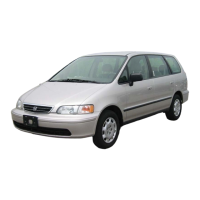
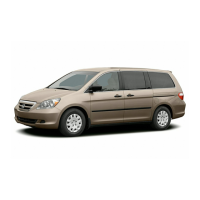
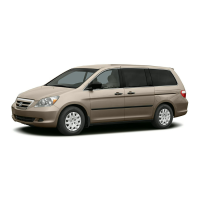
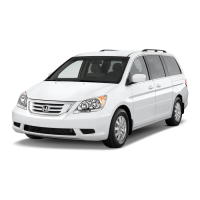



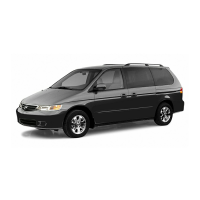


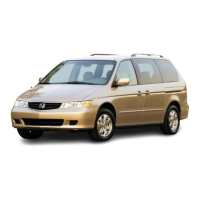
